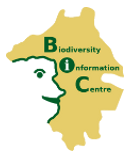Why an information centre?
Land use / cover change has shown to be the major threat to biodiversity, in particular in the tropics where highest species numbers and concentrations are found in rainforests. Deforestation in Africa is explained by the expansion of smallholder subsistence agriculture and domestic fuelwood extraction. Such pressure is particularly high in western Kenya with its rapidly growing population.
Kakamega Forest is placed in one of the most densely populated rural areas of Kenya. Gazetted as 238 kmē, the reserve is claimed to represent the easternmost relic of the Guineo-Congolian rainforest and is considered unique for its mix of west African lowland and afromontane species, several of which are endemic. Together with the two Nandi Forests it once formed one forest block. Today only 40% of the forest cover as at the beginning of the last century remains. Due to local demands as well as former commercial exploitation, disturbance levels are severe. Here, high biodiversity within the remaining forests is meeting high pressure from the surrounding intensively used landscapes.
As such the area can serve as a case model when looking into recommendations for a sustainable forest biodiversity manage- ment. However, this requires well informed and collaborating stakeholders as well as stimulation of local pride and of interest by scientists and the public (including tourists).



 Activities
Activities





